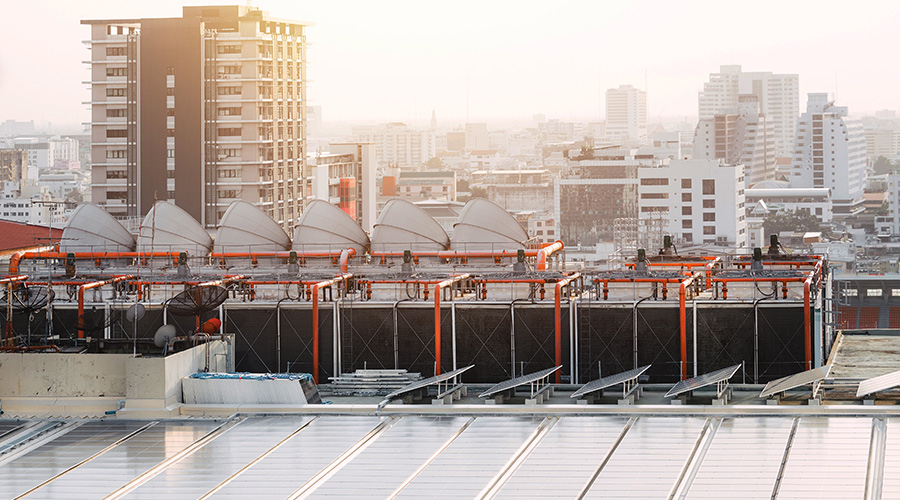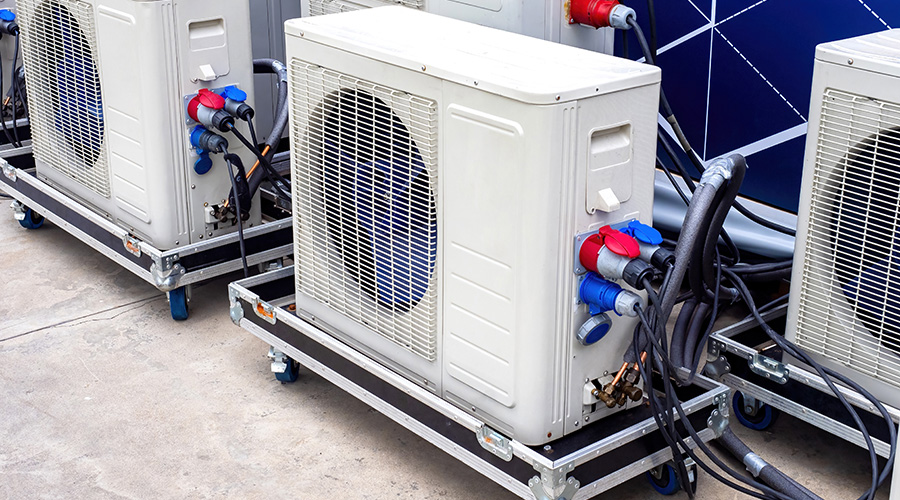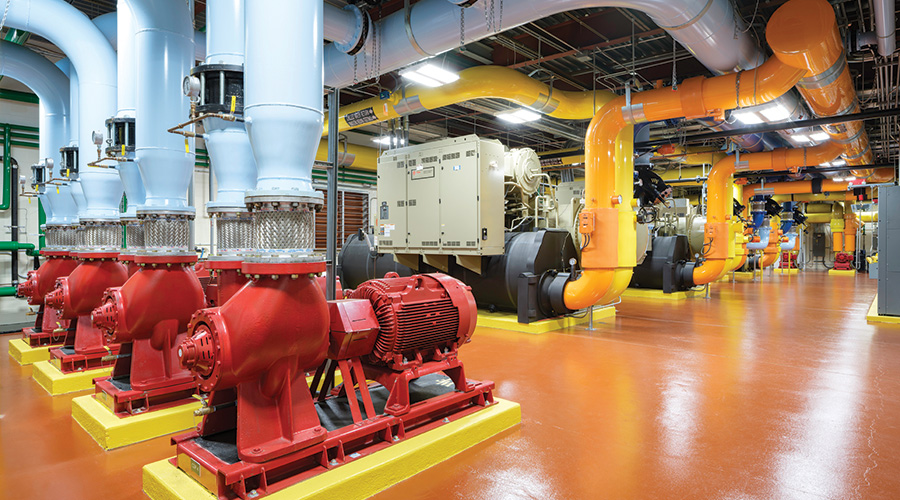The Future of Refrigerants: Essential Guide to Eco-Friendly Alternatives and the Transition Process
The AIM Act and resulting EPA actions are affecting critical decisions managers must make on refrigerants and equipment.
By Dan Hounsell, Senior Editor
For facility managers who experienced the phaseout of chlorofluorocarbons (CFCs) refrigerants used in building cooling systems in the 1990s, the federal government’s latest efforts to reduce the use of harmful substances in the atmosphere might seem familiar.
Enacted in 2020, the American Innovation and Manufacturing (AIM) Act of 2020 gives the U.S. Environmental Protection Agency (EPA) new regulatory authorization to address hydrofluorocarbon (HFC) refrigerants for environmental sustainability. The act directs the EPA to phase down production and consumption of HFCs to 15 percent of their baseline levels by 2036. It also aims to maximize reclamation and minimize releases of HFCs and their substitutes in equipment while easing the transition to next-generation technologies and refrigerants.
The first HFC refrigerant phasedowns started Jan. 1, 2020, with a 10 percent reduction in production, import and use. It was followed by an additional 30 percent reduction that began Jan. 1, 2024. As these regulations work to achieve a total 85 percent HFC phasedown from historic baseline levels by 2036, technology transition rules will start to impact the industry as early as Jan. 1, 2025.
“The allocation of the refrigerants is one of the EPA's levers to impact the supply chain,” says Jason Cornett, refrigeration technical manager with Henderson Engineers. “With the lever of the supply side, they're able to actually impact the entire market. What they're trying to do with the technology transition plan is to decrease the supply of high global warming potential (GWP) refrigerants — HFCs.”
Impact on refrigerants
The AIM Act and the EPA’s resulting actions are beginning to have the intended result on the supply of HFC refrigerants, but the results are still playing out.
"When they got rid of the ozone-depleting substances in the ‘90s, then people started going to these HFCs,” says Jennifer Markwardt, managing consultant with Trinity Consultants. “But then global warming happened. Now they're having to switch refrigerants, and I'm not sure that the development of refrigerants with low GWPs is going along as fast as it should be.
"It's been harder to find refrigerants that people can use going forward based on the rules. The AIM Act is phasing out the production and consumption of those refrigerants (HFCs). You won't be able to get them as much."
As a result, managers are having to learn about alternative refrigerants that can meet their needs related to equipment performance and comfort cooling in their facilities.
"Our main focus is on natural refrigerants, but the industry has also developed new HFO blends, which are hydrofluoroolefins,” Cornett says. “They actually had to have a new ASHRAE classification to basically differentiate them. They're called A2L refrigerants, and they are going to be very prevalent in HVAC. Most packaged equipment is going to start moving towards that direction.”
Equipment and technician considerations
To address refrigeration, air conditioning, and heat pump equipment, EPA is proposing regulations to control, where appropriate, practices, processes or activities related to the service, repair, disposal or installation of equipment that involves HFCs and their substitutes. The proposed rule would establish an emissions and reclamation program for managing certain HFCs and their substitutes that would include provisions that apply to new and existing equipment.
"Our approach is going to be to basically maximize the useful life of any equipment that's already in service,” Cornett says. “The EPA is not doing anything with that existing equipment other than basically saying you need to prove that you're not leaking over a certain threshold. Each type of equipment has a typical refrigerant leak rate, and if you exceed that leak rate, the EPA is going to say you need to get below that and prove it.”
The changes to refrigerants and their management mean there is a greater emphasis on the reporting and tracking of refrigerants by front-line technicians.
“If you're above the leak rate for the piece of equipment and you can't fix it, that would trigger a replacement eventually,” he says. “But for any existing equipment — chillers specifically — they're not going to make you tear that equipment out. They want to maximize the useful life of equipment that's in service. And the refrigerant that you use for that existing equipment is protected.”
For all the impacts of the AIM Act on refrigerant management and equipment considerations, the impact on technicians appears to be minimal.
"They didn't actually try to put in any kind of new training requirements for technicians,” Markwardt says. “So under ozone-depleting substances, they need to be certified once and there's no recertification requirements. There's no retraining under the rule. They may have to for their licensing but not for the EPA certification. There's no requirement to get recertified, and those certifications are good for all refrigerants.”
Management matters
For managers trying to plan their departments’ next moves on refrigerant management, one focus will be on leak detection in chillers, which will affect both the environment and the bottom line.
As the supply of HFC refrigerants drops, their cost will continue to rise. This projected increase in refrigerant cost makes having an aggressive leak-detection strategy important to the organization's bottom line. The higher cost means replenishing the charge of HFC refrigerants from a system with a leak will be higher than it has been. The earlier technicians can identify leaks, the more likely it is a leak can be stopped when minimal gas is released.
Cornett advises managers to take a closer look at both their facilities’ current refrigerant needs and the likely impact of using alternative refrigerants.
"If I'm talking to an end user, we're making them aware that this next refrigerant chemistry is going to solve your problems currently,” he says. “But down the line, you may have to switch away from it again. Do you want to do that for a fourth time? That's something you have to weigh.”
The varying and uncertain supply of HFC refrigerants is likely to affect facility decisions and operations for the near future.
"There's only a certain amount of HFCs allowed to be to be produced or imported in future years, and the phasedown is similar to what they did for ozone-depleting substances,” Markwardt says. “I think we're at 60 percent of the baseline, and starting in 2024, it'll go down from there down to 15 percent. Then there won't be any more that will be made. It'll be like R22 now. Either somebody's got a stockpile of it somewhere, or they've had it reclaimed from an appliance that they were using before.”
Ultimately, the HFC refrigerant phasedowns will affect not just refrigerant decisions but equipment decisions.
"When you buy new appliances, there are going to have to be different refrigerants being developed,” she says. “There are companies that are working on that, and the HFOs seem to work very well. But again, there's worry about flammability in some of those cases. I'm just not sure whether this rule is going to come in too fast for technology to catch up with it.
“That's what I would worry about as far as when you're buying new equipment. You can continue to use the refrigerants you have, but I've got people who are starting to have grief about spending hundreds of thousands of dollars to buy refrigerant to fix their large R22 systems. There's no reason to get rid of them unless you can't stomach that cost.”
Dan Hounsell is senior editor for the facilities market. He has more than 30 years of experience writing about facilities maintenance, engineering and management.
Related Topics:












